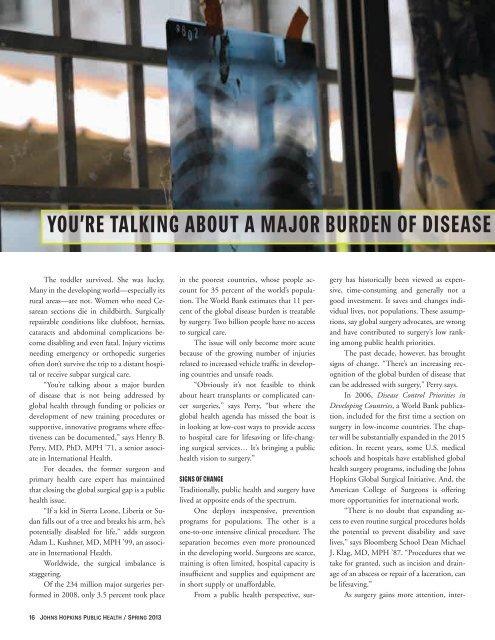this is global health
Download Low Resolution PDF - Johns Hopkins Public Health ...
Download Low Resolution PDF - Johns Hopkins Public Health ...
You also want an ePaper? Increase the reach of your titles
YUMPU automatically turns print PDFs into web optimized ePapers that Google loves.
YOu’re talking abOut a majOr burden Of diSeaSe<br />
The toddler survived. She was lucky.<br />
Many in the developing world—especially its<br />
rural areas—are not. Women who need Cesarean<br />
sections die in childbirth. Surgically<br />
repairable conditions like clubfoot, hernias,<br />
cataracts and abdominal complications become<br />
d<strong>is</strong>abling and even fatal. Injury victims<br />
needing emergency or orthopedic surgeries<br />
often don’t survive the trip to a d<strong>is</strong>tant hospital<br />
or receive subpar surgical care.<br />
“You’re talking about a major burden<br />
of d<strong>is</strong>ease that <strong>is</strong> not being addressed by<br />
<strong>global</strong> <strong>health</strong> through funding or policies or<br />
development of new training procedures or<br />
supportive, innovative programs where effectiveness<br />
can be documented,” says Henry B.<br />
Perry, MD, PhD, MPH ’71, a senior associate<br />
in International Health.<br />
For decades, the former surgeon and<br />
primary <strong>health</strong> care expert has maintained<br />
that closing the <strong>global</strong> surgical gap <strong>is</strong> a public<br />
<strong>health</strong> <strong>is</strong>sue.<br />
“If a kid in Sierra Leone, Liberia or Sudan<br />
falls out of a tree and breaks h<strong>is</strong> arm, he’s<br />
potentially d<strong>is</strong>abled for life,” adds surgeon<br />
Adam L. Kushner, MD, MPH ’99, an associate<br />
in International Health.<br />
Worldwide, the surgical imbalance <strong>is</strong><br />
staggering.<br />
Of the 234 million major surgeries performed<br />
in 2008, only 3.5 percent took place<br />
in the poorest countries, whose people account<br />
for 35 percent of the world’s population.<br />
The World Bank estimates that 11 percent<br />
of the <strong>global</strong> d<strong>is</strong>ease burden <strong>is</strong> treatable<br />
by surgery. Two billion people have no access<br />
to surgical care.<br />
The <strong>is</strong>sue will only become more acute<br />
because of the growing number of injuries<br />
related to increased vehicle traffic in developing<br />
countries and unsafe roads.<br />
“Obviously it’s not feasible to think<br />
about heart transplants or complicated cancer<br />
surgeries,” says Perry, “but where the<br />
<strong>global</strong> <strong>health</strong> agenda has m<strong>is</strong>sed the boat <strong>is</strong><br />
in looking at low-cost ways to provide access<br />
to hospital care for lifesaving or life-changing<br />
surgical services… It’s bringing a public<br />
<strong>health</strong> v<strong>is</strong>ion to surgery.”<br />
SignS Of cHange<br />
Traditionally, public <strong>health</strong> and surgery have<br />
lived at opposite ends of the spectrum.<br />
One deploys inexpensive, prevention<br />
programs for populations. The other <strong>is</strong> a<br />
one-to-one intensive clinical procedure. The<br />
separation becomes even more pronounced<br />
in the developing world. Surgeons are scarce,<br />
training <strong>is</strong> often limited, hospital capacity <strong>is</strong><br />
insufficient and supplies and equipment are<br />
in short supply or unaffordable.<br />
From a public <strong>health</strong> perspective, surgery<br />
has h<strong>is</strong>torically been viewed as expensive,<br />
time-consuming and generally not a<br />
good investment. It saves and changes individual<br />
lives, not populations. These assumptions,<br />
say <strong>global</strong> surgery advocates, are wrong<br />
and have contributed to surgery’s low ranking<br />
among public <strong>health</strong> priorities.<br />
The past decade, however, has brought<br />
signs of change. “There’s an increasing recognition<br />
of the <strong>global</strong> burden of d<strong>is</strong>ease that<br />
can be addressed with surgery,” Perry says.<br />
In 2006, D<strong>is</strong>ease Control Priorities in<br />
Developing Countries, a World Bank publication,<br />
included for the first time a section on<br />
surgery in low-income countries. The chapter<br />
will be substantially expanded in the 2015<br />
edition. In recent years, some U.S. medical<br />
schools and hospitals have establ<strong>is</strong>hed <strong>global</strong><br />
<strong>health</strong> surgery programs, including the Johns<br />
Hopkins Global Surgical Initiative. And, the<br />
American College of Surgeons <strong>is</strong> offering<br />
more opportunities for international work.<br />
“There <strong>is</strong> no doubt that expanding access<br />
to even routine surgical procedures holds<br />
the potential to prevent d<strong>is</strong>ability and save<br />
lives,” says Bloomberg School Dean Michael<br />
J. Klag, MD, MPH ’87. “Procedures that we<br />
take for granted, such as inc<strong>is</strong>ion and drainage<br />
of an abscess or repair of a laceration, can<br />
be lifesaving.”<br />
As surgery gains more attention, inter-<br />
16 Johns hopkins public <strong>health</strong> / spring 2013


